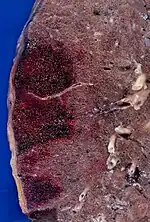Hemorrhagic infarct
Hemorrhagic infarcts are infarcts commonly caused by occlusion of veins, with red blood cells entering the area of the infarct, or an artery occlusion of an organ with collaterals or dual circulation. These are typically seen in the brain,[1] lungs, and the GI tract, areas referred to as having "loose tissue," or dual circulation. Loose-textured tissue allows red blood cells released from damaged vessels to diffuse through the necrotic tissue. A white infarct, also called an anemic infarct, can become hemorrhagic with reperfusion. Hemorrhagic infarction is also associated with testicular torsion.[2]
| Hemorrhagic infarct | |
|---|---|
 | |
| Recent hemorrhagic infarcts. | |
| Specialty | Vascular surgery |
See also
References
- gliageek. "Vascular Disease 1: Reaction to ischemic injury". FrontalCortex.com. Retrieved 22 September 2015.
- Goljan, Edward (2011). Rapid Review Pathology. Philadelphia: Elsevier Mosby. p. 425. ISBN 9780323084383.
This article is issued from Wikipedia. The text is licensed under Creative Commons - Attribution - Sharealike. Additional terms may apply for the media files.